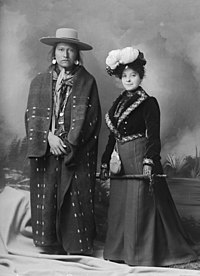


Tindoor, chief of the Lemhi Shoshone and his wife, Idaho, ca. 1897, photograph by Benedicte Wrensted
| |
| Regions with significant populations | |
|---|---|
| Languages | |
| Shoshone,[1] English | |
| Religion | |
| Native American Church, Sun Dance, traditional tribal religion,[2] Christianity, Ghost Dance | |
| Related ethnic groups | |
| other Shoshone people, Bannock |

Northern Shoshone are Shoshone of the Snake River Plain of southern Idaho and the northeast of the Great Basin where Idaho, Wyoming and Utah meet. They are culturally affiliated with the Bannock people and are in the Great Basin classification of Indigenous People.
Northern Shoshone is a dialect of the Shoshone language, a Central Numic language in the Uto-Aztecan language family. It is primarily spoken on the Fort Hall and Wind River reservations in Idaho and Wyoming, respectively.[1]
Bands of Shoshone people were named for their geographic homelands and for their primary foodsources.
Mountain Shoshone bands:
Northwestern Shoshone bands:
Fort Hall Shoshone Bands:
Western Bands of Northern Shoshone:
The Northern Shoshone have people who are members of three federally recognized tribes in Idaho and Utah: